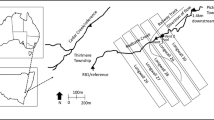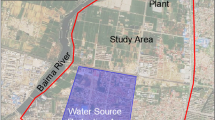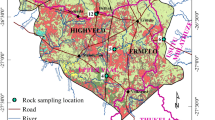Abstract
Acid mine drainage and metal loads from hardrock mines to surface waters is a significant problem in the western USA and many parts of the world. Mines often occur in mountain environments with fractured bedrock aquifers that serve as pathways for metals transport to streams. This study evaluates impacts from current and potential future groundwater metal (Cd, Cu, and Zn) loads from fractures underlying the Gilt Edge Mine, South Dakota, on concentrations in Strawberry Creek using existing flow and water quality data and simple mixing/dilution mass balance models. Results showed that metal loads from bedrock fractures to the creek currently contribute <1% of total loads. Even if background water quality is achieved upstream in Strawberry Creek, fracture metal loads would be <5%. Fracture loads could increase substantially and cause stream water quality standards exceedances once groundwater with elevated metals concentrations in the aquifer matrix migrates to the fractures and discharges to the stream. Potential future metal loads from an upstream fracture would contribute a small proportion of the total load relative to current loads in the stream. Cd has the highest stream concentrations relative to standards. Even if all stream water was treated to remove 90% of the Cd, the standard would still not be achieved. At a fracture farther downstream, the Cd standard can only be met if the upstream water is treated achieving a 90% reduction in Cd concentrations and the median stream flow is maintained.
Similar content being viewed by others
References
Aeschbach-Hertig, W., Schlosser, P., Stute, B., Simpson, H. J., Ludin, A., & Clark, J. F. (1998). H-3/He-3 study of groundwater flow in a fractured bedrock aquifer. Ground Water, 36(4), 661–670.
Baek, I., & Pitt, W. W. Jr. (1996). Colloid facilitated radionuclide transport in fractured porous rock. Waste Management, 16(4), 313–325.
Bencala, K. E. (2000). Hyporheic zone hydrological processes. Hydrological Processes, 14, 2797–2798.
Bencala, K. E. (2005). Hyporheic exchange flows. In M. G. Anderson (Ed.), Encyclopedia of hydrological sciences (Vol. 3(10), Chapter 113, pp. 1–7). New York: Wiley.
Caine, N. (2001). The geomorphic systems of Green Lakes Valley. In W. D. Bowman & T. R. Seastedt (Eds.), Structure and function of an alpine ecosystem: Niwot Ridge, Colorado (pp. 45–74). New York: Oxford University Press.
Caruso, B. S. (2003). Water quality simulation for planning restoration of a mined watershed. Water, Air and Soil Pollution, 150(1–4), 221–234.
Caruso, B. S., & Wangerud, K. (2002). Deterministic and stochastic water balance modeling of the Gilt Edge Mine Superfund Site, South Dakota. Society for Mining, Metallurgy, and Exploration Transactions, 312, 104–112.
Caruso, B. S., & Ward, R. C. (1998). Assessment of nonpoint source pollution from inactive mines using a watershed-based approach. Environmental Management, 22(2), 225–243.
CDM (2002). Site Surface Water Report, Gilt Edge Mine NPL Site, Lawrence County, South Dakota, Draft Report. Prepared for US Environmental Protection Agency Region 8, Denver, CO.
CDM (2003). Strawberry Creek and Bear Butte Creek Surface Water, Sediment, and Bank Material Measurement Report, Gilt Edge Mine NPL Site, Lawrence County, South Dakota, Interim Status Report. Prepared for US Environmental Protection Agency Region 8, Denver, CO.
CDM (2006). Gilt Edge Mine Superfund Site, Lawrence County, South Dakota, Groundwater Monitoring Report — Update. Prepared for US Environmental Protection Agency Region 8, Denver, CO.
Church, S. E., von Guerard, P., & Finger S. E. (Eds.) (2007). Integrated investigations of environmental effects of historical mining in the Animas River Watershed, San Juan County, Colorado, U.S. Geological Survey Professional Paper, 1651, 417–495.
Day-Lewis, F. D., Lane, J. W., & Gorelick, S. M. (2006). Combined interpretation of radar, hydraulic, and tracer data from a fractured-rock aquifer near Mirror Lake, New Hampshire, USA. Hydrogeology Journal, 14, 1–14.
Diodata, D. M. (1994). A compendium of fracture flow models - 1994. Center for Environmental Restoration Systems, Energy Systems Division, Argonne National Laboratory. Chicago, IL.
EPA (2001). Abandoned mine site characterization and clean-up handbook. EPA530-R-01-002. Washington, DC: Office of Solid Waste and Emergency Response.
EPA (2002). National recommended water quality criteria; 2002. EPA-822-R-02-047. Washington, DC: Office of Water.
Esposito, S. J., & Thomson, N. R. (1999). Two-phase flow and transport in a single fracture-porous medium system. Journal of Contaminant Hydrology, 37(3–4), 319–341.
Folger, P. F., Poeter, E., Wanty, R. B., Frishman, D., & Day, W. (1996). Controls on 222-Rn variations in a fractured crystalline rock aquifer evaluated using aquifer tests and geophysical logging. Ground Water, 34(2), 250–261.
Gandy, C. J., Smith, J. W. N., & Jarvis, A. P. (2007). Attenuation of mining-derived pollutants in the hyporheic zone: A review. Science of the Total Environment, 373, 435–446.
Gburek, W. J., Folmar, G. J., and Urban, J. B. (1999). Field data and groundwater modeling in a layered fractured aquifer. Ground Water, 37(2), 175–184.
Gernand, J. D., & Heidtman, J. P. (1997). Detailed pumping test to characterize a fractured bedrock aquifer. Ground Water, 35(4), 632–637.
Kimball, B. A., Runkel, R. L., Walton-Day, K., & Bencala, K. E. (2002). Assessment of metal loads in watersheds affected by acid mine drainage by using tracer injection and synoptic sampling: Cement Creek, Colorado, USA. Applied Geochemistry, 17, 1183–1207.
Kimball, B. A., Runkel, R. L., Walton-Day, K., & Williamson, J. E. (2006). Quantification of mass loading to Strawberry Creek near the Gilt Edge mine, Lawrence County, South Dakota, June 2003. US Geological Survey Scientific Investigations Report 2006-5006, 41 p.
Kinner, N. E., Masters, R. W., & Fournier, L. B. (2005). Fractured rock: State of the science and measuring success in remediation. U.S. Environmental Protetion Agency, Office of Solid Waste and Emergency Response, Technology Innovation Program. Retrieved June 2008 from http://cluin.org/download/remed/fractured_rock_summary.pdf.
McKay, L. D., Stafford, P. L., & Toran, L. E. (1997). EPM modeling of a field-scale tritium tracer experiment in fractured, weathered shale. Ground Water, 35(6), 997–1007.
Medine, A. J., Martin, J. L., & Sopher, E. J. (2002). Development of the metal speciation-based Metal Exposure and Transformation Assessment model (META4): Application to copper and zinc problems in the Alamosa River, Colorado. In R. L. Lipnick, R. P. Mason, M. L. Phillips, & C. U. Pittman (Eds.), Fate and transport of chemicals in the environment: Impacts, monitoring and remediation. Washington: ACS.
Meixner, T., Bales, R. C., Williams, M. W., Campbell, D. H., & Baron, J. S. (2000). Stream chemistry modeling of two watersheds in the Front Range, Colorado. Water Resources Research, 36(1), 77–87.
Melack, J. M., & Stoddard, J. L. (1991). Acidic deposition and aquatic ecosystems: Sierra Nevada, California. In D. F. Charles (Ed.), Regional case studies: Acidic atmospheric deposition and ecological consequences (pp. 503–530). New York: Springer.
Mukhopadhyay, S., & Cushman, J. H. (1998). Monte Carlo simulation of contaminant transport: I. Long-range correlations in fracture conductivity. Transport in Porous Media, 31(2), 145–181.
Paillet, F. L. (2004). Geophysical characterization of fractured rock aquifers: Accounting for scale effects and putting hydrology in the geophysics. Paper presented at the 2004 US EPA/NGWA Fractured Rock Conference, Portland, Maine, September.
Parker, B. L., McWhorter, D. B., & Cherry, J. A. (1997). Diffusive loss of non-aqueous phase organic solvents from idealized fracture networks in geologic media. Ground Water, 35(6), 1077–1088.
Paulson, A. (2001). Biogeochemical removal of Zn and Cd in the Coeur Alene River (Idaho, USA), downstream of a mining district. The Science of the Total Environment, 278, 31–44.
Runkel, R. L., & Kimball, B. A. (2002). Evaluating remedial alternatives for an acid mine drainage stream: Application of a reactive transport model. Environmental Science and Technology, 36(5), 1093–1101.
Runkel, R. L., Kimball, B. A., McKnight, D. M., & Bencala, K. E. (1999). Reactive solute transport in streams: A surface complexation approach for trace metal sorption. Water Resources Research, 35(12), 3829–3840.
Runkel, R. L., McKnight, D. M., & Rajaram, H. (2003). Modeling hyporheic zone processes. Advances in Water Resources, 26, 901–905.
Shapiro, A. M. (2002). Fractured-rock aquifers: Understanding an increasingly important source of water. USGS Fact Sheet 112-02.
Steimle, R. (2001). The state of the practice: Characterizing and remediating contaminated groundwater at fractured rock sites. Remediation, Spring, 23–33.
Tonkin, J. W., Balistrieri, L. S., & Murray, J. W. (2002). Modeling metal removal onto natural particles formed during mixing of acid rock drainage with ambient surface water. Environmental Science and Technology, 36, 484–492.
Wireman, M. (2002). Characterizing and managing ground-water resources in fractured-rock hydrogeological settings. Paper presented at Fractured-Rock Aquifers 2002, National Ground Water Association, Denver, CO, March.
Wood, W. W., Kraemer, T. F., & Shapiro, A. (2004). Radon (222Rn) in ground water of fractured rocks: A diffusion/ion exchange model. Ground Water, 42, 552–567.
Wool, T. A., Ambrose, R. B., Martin, J. L., & Comer, E. A. (2001). Water Quality Analysis Simulation Program (WASP) version 6.0 draft: User’s manual. US Environmental Protection Agency. Retrieved April 2008 from http://www.epa.gov/athens/wwqtsc/html/wasp.html.
Zaramella, M., Marion, A., & Packman, A. I. (2006). Applicability of the Transient Storage Model to the hyporheic exchange of metals. Journal of Contaminant Hydrology, 84, 21–35.
Author information
Authors and Affiliations
Corresponding author
Rights and permissions
About this article
Cite this article
Caruso, B.S., Dawson, H.E. Impacts of groundwater metal loads from bedrock fractures on water quality of a mountain stream. Environ Monit Assess 153, 405–425 (2009). https://doi.org/10.1007/s10661-008-0367-6
Received:
Accepted:
Published:
Issue Date:
DOI: https://doi.org/10.1007/s10661-008-0367-6




